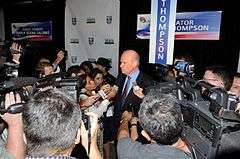Spin room

A spin room, also known as spin row[1] or spin alley,[2][3] is an area in which reporters can speak with debate participants and/or their representatives after a debate. The name refers to the fact that the participants will attempt to "spin" or influence the perception of the debate among the assembled reporters. The benefit for reporters is that they quickly get in-person interviews with debaters or their representatives, complete with audio, video and photos. For a U.S. presidential debate, the number of reporters in the spin room can number into the thousands.[4]
History
The earliest known spin room was set up by the campaign of U.S. president Ronald Reagan in 1984. In a hotel banquet room, campaign officials spoke on the record with talking points playing up their own candidate's debate performance and minimizing opponent Walter Mondale's success, despite many observers believing Mondale had just won. This operation was dubbed the "spin patrol."[5]
Operation
A spin room may also be active before a debate.[6] A common form of pre-debate spin is for each side to try to raise expectations for the opposing debater and lower expectations for their own team, a pursuit known as playing the expectations game.[7]
Criticism
Some observers have criticized the overt nature of the media manipulation in spin rooms, and the media's willing participation in it.[3][8][9] Defenders have said reporters know it's scripted and aren't persuaded by the spin, but rather, they use the talking points to analyze candidates' strategies.[10] Spin rooms can occasionally include moments of candor, such as when presidential candidate Rick Perry admitted that he had "stepped in it" during a debate response that became known as his "oops" moment.[11]
Spin rooms have also been portrayed as outdated in an era of instant online reaction from all quarters before a debate is even over.[4][12] Focus groups and instant post-debate "snap polls" attempt to provide a more scientific method than spin rooms in determining who has won a debate.[13][14]
See also
References
- ↑ Reaves, Jessica (4 October 2000). "As the Spin Room Turns". Time. Retrieved 2 October 2012.
- ↑ Mathes, Michael (23 October 2012). "Spin Alley: getting out the message over debate din". Agence France-Presse. Retrieved 23 October 2012.
- 1 2 Rosenthal, Phil (26 September 2008). "Spin room coverage out of control". Chicago Tribune. Retrieved 2 October 2012.
- 1 2 Calderone, Michael (1 October 2012). "For 2012 Presidential Debates, Campaigns Speed Up The Spin". The Huffington Post. Retrieved 2 October 2012.
- ↑ Santini, Maureen (13 October 1984). "'Spin patrol' spins out". The Evening News. Newburgh-Beacon, New York. The Associated Press. Retrieved 18 October 2012.
- ↑ Miller, Zeke (17 October 2012). "Before The Spin Room, Campaigns Pre-Wash The Press". BuzzFeed. Retrieved 17 October 2012.
- ↑ Caldwell, Leigh Ann (10 October 2012). "What's behind the debate expectations game?". CBS News. Retrieved 17 October 2012.
- ↑ Rosen, Jay (22 November 2003). "Raze Spin Alley, That Strange Creation of the Press". PressThink. Retrieved 23 October 2012.
- ↑ Lanson, Jerry (12 December 2003). "The spin room - oily engine of the political meat grinder". The Christian Science Monitor. Retrieved 17 October 2012.
- ↑ Hardman, Isabel (30 April 2015). "A (partial) defence of the spin room". The Spectator. Retrieved 6 August 2015.
- ↑ "Perry in spin room explains flub: "I stepped in it" (with video)". PoliTex. 9 November 2011. Retrieved 6 August 2015.
- ↑ Gaudin, Sharon (4 October 2012). "Twitter becomes new debate spin room". Computer World. Retrieved 17 October 2012.
- ↑ "US presidential debate: Early polls give Barack Obama slender victory". The Telegraph. 27 September 2008. Retrieved 15 October 2015.
- ↑ "Clegg Beats Brown, Cameron in U.K. TV Debate, Polls Show". Bloomberg. 16 April 2010. Retrieved 9 November 2012.